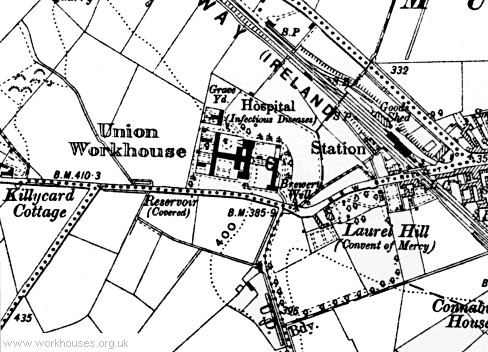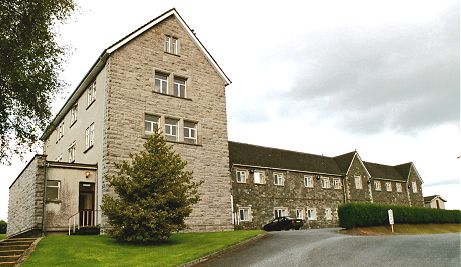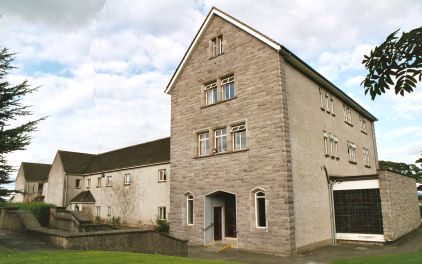Castleblayney, Co. Monaghan
Castleblayney (or Castleblaney) Poor Law Union was formally declared on the 8th November 1839 and covered an area of 146 square miles. Its operation was overseen by an elected Board of Guardians, 22 in number, representing its 18 electoral divisions as listed below (figures in brackets indicate numbers of Guardians if more than one):
Co. Monaghan:
Annayalla, Ballybay (2), Bellatrain, Broomfield, Carrickaslane, Castleblaney (2), Churchill (2), Creeve (2), Cremartin (2), Greagh, Laragh, Mullyash.
Co. Armagh:
Camly, Creggan, Crossmaglen, Dorsy, Sheetrim, Newtown Hamilton.
The Board also included 7 ex-officio Guardians, making a total of 29. The Guardians met each week on Wednesday.
The population falling within the Union at the 1831 census had been 56,505 with divisions ranging in size from Laragh (population 2,135) to Castleblayney itself (5,202).
The new Castleblayney Union workhouse was erected on a eight-acre site at the west of Castleblayney. Designed by the Poor Law Commissioners' architect George Wilkinson, the building was based on one of his standard plans to accommodate 800 inmates. Its construction cost £6,150 plus £1,289 for fittings etc. The workhouse was declared fit for the reception of paupers on 25th October 1842 and admitted its first inmates on 15th December. The workhouse location and layout are shown on the 1910 map below.

Castleblayney workhouse site, 1910
The buildings followed Wilkinson's typical layout. An entrance and administrative block at the east contained a porter's room and waiting room at the centre with the Guardians' board room on the first floor above. It was later extended at its southern end to provide children's accommodation and schoolrooms.

Castleblayney entrance block from the south-east, 2003.
© Peter Higginbotham.

Castleblayney entrance block from the south-west, 2003.
© Peter Higginbotham.
The main accommodation block had the Master's quarters at the centre, with male and female wings to each side. At the rear, a range of single-storey utility rooms such as bakehouse and washhouse connected through to the infirmary and idiots' wards via a central spine containing the chapel and dining-hall.
During the famine in the mid-1840s, a 60-bed fever hospital was erected at the north-west of the workhouse. A burial ground lay to its north.
In 1895, the workhouse was visited by a "commission" from the British Medical Journal investigating conditions in Irish workhouse infirmaries. Their report found much to criticise, particularly the poor sanitary provisions, and the wards for the aged and infirm which were "dark, uninviting, and cheerless." Further details are available in the full report. The BMJ's revelations contributed to the introduction of significant improvements in the standard of Irish workhouse nursing, with the employment of pauper inmates ending ending after the passing of 1898 Local Government Act.
At the 1901 census, the population of the Union was 26,615.
The workhouse, together with the other three in the county, was closed on 1 April 1921. The building was subsequently converted for use as a County Home to accommodate the elderly and infirm. The site later became St Mary's Hospital, with only the entrance block now (2003) surviving.
Records
Note: many repositories impose a closure period of up to 100 years for records identifying individuals. Before travelling a long distance, always check that the records you want to consult will be available.
- Clones Branch Library, 98 Avenue, Clones, Co Monaghan. Holdings include Guardians' minutes and correspondence c.1840-1933.
Bibliography
- Crossman, V (2006) Politics, Pauperism and Power in Late Nineteenth-century Ireland
- Gould, Michael H (1983) The Workhouses of Ulster
- Gray, P (2009) The Making of the Irish Poor Law, 1815-43
- O'Connor, J (1995) The Workhouses of Ireland
Links
- None.
Unless otherwise indicated, this page () is copyright Peter Higginbotham. Contents may not be reproduced without permission.


